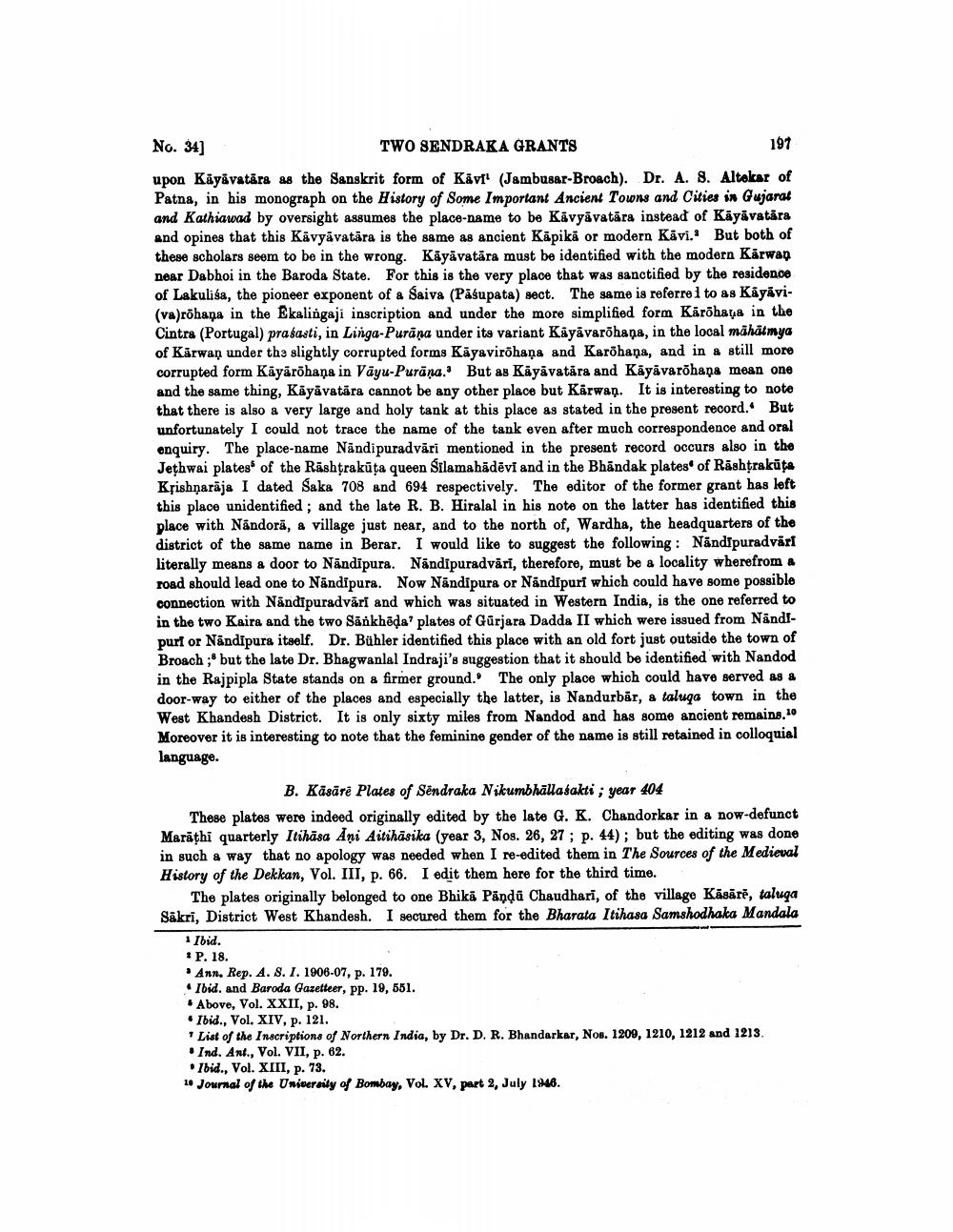________________
No. 34] TWO SENDRAKA GRANTS
197 upon Käyávatāra as the Sanskrit form of Kāvi' (Jambusar-Broach). Dr. A. 8. Altokar of Patna, in his monograph on the History of Some Important Ancient Towns and Cities in Gujarat and Kathiawad by oversight assumes the place-name to be Kävyävatāra instead of Kāyāvatāra and opines that this Kavyāvatāra is the same as ancient Käpikä or modern Kåvi. But both of these scholars seem to be in the wrong. Käyāvatāra must be identified with the modern Kārwan near Dabhoi in the Baroda State. For this is the very place that was sanctified by the residence of Lakulisa, the pioneer exponent of a Saiva (Pasupata) sect. The same is referre i to as Käyāvi. (va)rohana in the Ekalingaji inscription and under the more simplified form Kärõhaya in the Cintra (Portugal) prasasti, in Linga-Purāna under its variant Kayavaröhana, in the local mahatmya of Karwan under the slightly corrupted forms Kāyavirõhana and Karohana, and in a still more corrupted form Kāyārõhana in Vāyu-Purāņa. But as Käyāvatāra and Käyāvarāhana mean one and the same thing, Käyávatāra cannot be any other place but Karwan. It is interesting to note that there is also a very large and holy tank at this place as stated in the present record. But unfortunately I could not trace the name of the tank even after much correspondence and oral enquiry. The place-name Nandipuradväri mentioned in the present record occurs also in the Jethwai plates of the Rashtrakūta queen Silamahädēvi and in the Bhandak plates of Rashtrakūta Krishnarāja I dated Saka 708 and 694 respectively. The editor of the former grant has left this place unidentified; and the late R. B. Hiralal in his note on the latter has identified this place with Nándoră, a village just near, and to the north of, Wardha, the headquarters of the district of the same name in Berar. I would like to suggest the following: Nandipuradvár literally means a door to Nandipura. Nandipuradväri, therefore, must be a locality wherefrom a road should lead one to Nandipura. Now Nandipura or Nandipur which could have some possible connection with Nandipuradväri and which was situated in Western India, is the one referred to in the two Kaira and the two Sänkhöda' plates of Gurjara Dadda II which were issued from Nandipurt or Nandipura itself. Dr. Bühler identified this place with an old fort just outside the town of Broach ; but the late Dr. Bhagwanlal Indraji's suggestion that it should be identified with Nandod in the Rajpipla State stands on a firmer ground. The only place which could have served as a door-way to either of the places and especially the latter, is Nandurbar, a taluqa town in the West Khandesh District. It is only sixty miles from Nandod and has some ancient remains.10 Moreover it is interesting to note that the feminine gender of the name is still retained in colloquial language.
B. Kasāre Plates of Sendraka Nikumbhālasakti; year 404 These plates were indeed originally edited by the late G. K. Chandorkar in a now-defunct Marathi quarterly Itihāsa Ani Aitihäsika (year 3, Nos. 26, 27 ; p. 44); but the editing was done in such a way that no apology was needed when I re-edited them in The Sources of the Medieval History of the Dekkan, Vol. III, p. 66. I edit them here for the third time.
The plates originally belonged to one Bhika Pandu Chaudhari, of the village Käsärë, taluga Säkri, District West Khandesh. I secured them for the Bharata Itihasa Samshodhaka Mandala
1 Ibid. * P. 18. . Ann. Rep. A. 8.1. 1906-07, p. 179.
Ibid. and Baroda Gazetteer, pp. 19, 551. Above, Vol. XXII, p. 98. • Ibid., Vol. XIV, p. 121. List of the Inscriptions of Northern India, by Dr. D. R. Bhandarkar, Nos. 1209, 1210, 1212 and 1213 Ind. Ant., Vol. VII, p. 62.
Ibid., Vol. XIII, p. 73. 16 Journal of the University of Bombay, Vol. XV, part 2, July 1946.




